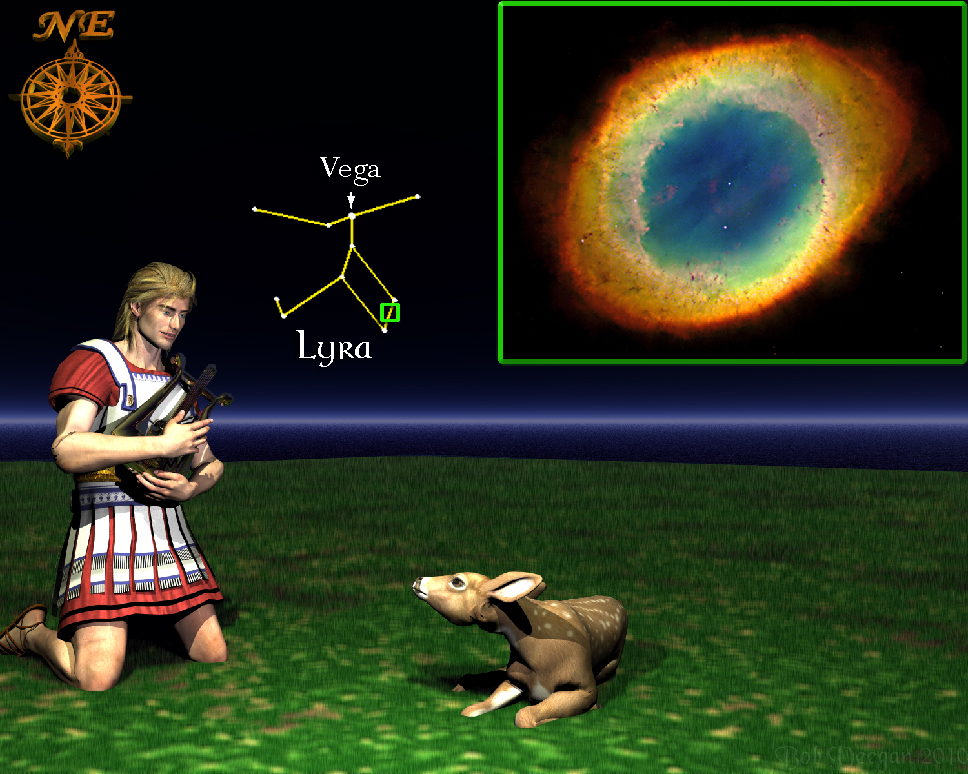
For the week including May 28, 2010

THE LYRE
Close to the eastern horizon after sundown you can see a conspicuously bright blue-white star. This is Vega in the constellation of Lyra, the Lyre, a seven-stringed harp. The most popular legend about the Lyre, traces back to ancient Greece. Hermes, the messenger of the gods, invented the instrument and presented an enchanted one to the sun-god Apollo, who in turn gave it to Orpheus, his son. Orpheus was a handsome young man already renowned for his songs and poetry, but when Apollo gave him the magical lyre, his livelihood got a real boost. His music completely charmed people and animals and as time went on Orpheus found that he could enthrall trees, mountains, and even the sea itself. His truest happiness though, was embodied in his devoted wife, Eurydice and their love for each other was the subject of most of his compositions. When she died of a snake bite, his grief was such that friends thought he would soon join her. Eventually, in one of the great adventures of Greek mythology, Orpheus traveled to the Underworld to beg its ruler, Hades, for the life of his wife. Orpheus played all his songs of love, dedication, and loss until he dropped from exhaustion. In the end, Hades took pity, telling him to return home and that Eurydice would follow him, but he must not look back at her until he reached his destination. On the way, Orpheus stumbled and glanced back only to see the sorrow on his wife’s face as she faded back to the Underworld forever. Things had been bad and now they were worse. What better way to heal Orpheus, his friends thought, but to get him back to his music. And, unfortunately, that’s why Orpheus ended up doing that concert for the Maenads. The Maenads were female devotees of the wine-god Dionysus and as Orpheus-groupies go, they were truly dedicated. Throughout his career, wherever Orpheus went, crowds of Maenads would camp outside his hotel and make an adoring nuisance of themselves. The agent that booked Orpheus forgot to mention that the Maenads had decided to combine his performance with one of their festivals celebrating Dionysus. These rowdy parties were most often associated with the arrival of spring, but they were also known for broken furniture, speeding tickets, and terrible hangovers. By all accounts, things went very well for a while. Police reports of the time were rather sketchy, so nobody knows exactly how it started, but, after the show, while Orpheus was signing autographs backstage, the Maenads got into an argument about which one of them would be the best replacement for Eurydice. Somehow, as they quarreled over who loved him the most, a tug of war developed with Orpheus in the middle and before long the Maenads had torn him to pieces. The merrymaking broke up soon after. It was left to the Muses to decide what to do with the enchanted lyre and since an eBay auction wasn’t feasible, they placed it among the stars where we can see it today.
The Ring Nebula (upper right): If you look inside our illustration’s square through a backyard telescope, the Ring Nebula looks like a gray-green smoke ring set among the stars.This “ghostly doughnut” is half a light year across, which is about 30,000 times the distance from the Earth to the Sun. Measurements have shown the Ring to be about 20,000 years old and expanding away from its dying host star at the rate of twelve miles per second.Unless otherwise indicated, all content of this web site is the copyright of Robert Deegan and all rights are reserved.
For more information, or to comment, please contact: Bob@NightSkies.org